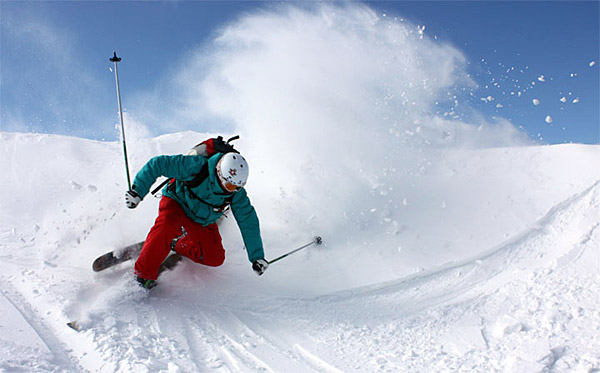Danko Puskaric, Ski Training - How to Ski All Day, Volume 2, The Truth About Skiing (Infostudio Inc., March 2012), Amazon Digital Services, Kindle Edition, $0.99.
Review by John Sherwood, DCSki Columnist
We all know the feeling. It’s Monday, the day after our first weekend of the ski season, and we can barely get out of bed. Muscles we never even thought existed are screaming in agony, and it takes days for the pain to end. How did this happen? For those of us who regularly run or cycle and think we are fit for the slopes, such pain is particularly demoralizing.
For the past three ski seasons, I have augmented aerobic conditioning with strength training. My trainer-directed program involves upper body, lower body, and core conditioning plus balance, flexibility, and cardio work. Every two weeks, I meet with the trainer to modify the program and have her gauge my progress. Since I have added strength training to my fitness regimen, I have experienced little if any pain after skiing, and my recovery time has been faster after falls and other mishaps. Transitioning from Timberline, my home resort, to bigger mountains also has been easier, as have adjustments to higher altitudes.
Ski Training - How to Ski All Day explains why a combination of strength training and aerobic conditioning is so important for skiers and snowboarders, not only for people who want to ski all day and not be sore, but for those keen on avoiding injuries as well. Skiing and snowboarding are dynamic sports that place stress on muscles not always utilized in day to day activities. Because skiing involves frequent breaks (for lift rides, lodge stops, etc.), it’s not usually aerobic, so it’s easy to be lulled into a false sense of complacency about the level of fitness required. The ski industry rarely emphasizes the physical aspect of the sport either. You’ll never see a drop of sweat on any skier images posted on a resort’s web site. But make no mistake about it, skiing and snowboarding are intensely physical activities that require strong bursts of energy, superior core and lower body conditioning, as well as balance and flexibility. Anyone who has experienced the pain associated with being out of shape can attest to these basic truths.

|
|
|
Danko Puskaric, a professor of physics and an avid Croatian snowboarder, offers advice designed to improve the physical fitness of the skier without cutting too deeply into his or her schedule. His book offers an intensive 45-day ski fitness plan, a year-long conditioning program, and fitness advice for the actual ski day. Both the 45-day plan and the year-long program recommend three gym workouts a week plus some sort of fitness activity on the weekends such as hiking or cycling. The gym workouts consist of 45-60 minutes of strength training followed by 30-minute aerobic workouts. His plan is designed not only to build strength but reduce fat and increase stamina.
The strength component of the workout calls for back, posterior, deltoid, bicep, and forearm work for the first gym session of the week; leg, calve, and abdominal work for the second session; and chest, medial deltoid, and triceps work for the third day. Thirty minutes of aerobic conditioning on the treadmill, elliptical, or stationary bike should follow each strength workout and stretching should be done at the very end of the session. Gym days should be broken up with rest days. While skiing draws mainly on lower body and core muscles, the author encourages his readers to devote some effort to upper body because those muscles often activate during falls and accidents. Aerobic conditioning improves stamina and helps skiers with altitude adjustment.
Ski Training - How to Ski All Day provides detailed descriptions of recommended exercises - some of which are specifically selected with skiing in mind, and emphasize lateral movement, balance, etc. Others are good, basic exercises that anyone looking to improve his or her general fitness should consider adopting. For aerobic benchmarks, the author refers to the U.S. Army Cooper test, which explains how many meters people from different age cohorts should be able to run in 12 minutes. He also provides tables of target heart rates for aerobic conditioning and discusses the benefits of interval training.
In reading this book, I was pleased to learn that my trainer has incorporated just about every exercise listed at one point or another into my routines. The book provided me with positive reinforcement for the program I am already embarked upon and offered me some tips on things to emphasize as we get closer to the season. Puskaric’s section on warm-up exercises and end of day exercises for ski days also will be of great value when I finally get to the slopes.

|
|
Photo provided by Danko Puskaric.
|
For someone not accustomed to strength training, Professor Puskaric’s program will be of even more utility. For those just starting a new fitness regimen, he strongly recommends discussing fitness with one’s doctor first and then working with a trainer for the first few weeks or longer before branching out on one’s own. If one cannot afford a trainer, however, this book provides an excellent program for the novice just beginning his or her gym odyssey.
Ski Training - How to Ski All Day is part of a six volume series of e-books. Other volumes cover such themes as diet for skiing, ski injuries, ski safety, ski equipment, and backcountry skiing. Puskaric’s emphasis is not on ski technique, which he feels is best left to ski instructors on the slopes, but contains all the other information one needs to be a safe and effective skier. I have only read Ski Training, but am impressed enough to read more volumes in the series. At only 99 cents per e-book, these books are a bargain.
And one final note about the author’s Croatian connection. Croatia is the home of one of my favorite skiers of all-time, Janica Kostelić. Kostelić came out of nowhere to win four gold medals at the 2002 Salt Lake City Olympics - the only woman to ever achieve such an honor. One of the secrets behind her success was the fitness program developed by her father. For lack of training funds, Kostelić trained with anything available. She and her brother, Ivica (a World Cup champion) would lift logs, balance on fences, and run along steep, rocky cliffs during the offseason. Superior physical conditioning helped Kostelić overcome knee surgeries and other ailments to achieve superior results. While this book will not transform you into another Kostelić, it’s simple, no-nonsense program will help you achieve your personal best.
John Sherwood is a columnist for DCSki. When he's not hiking, biking, or skiing, he works as an author of books on military history.

Join the conversation by logging in.
Don't have an account? Create one here.